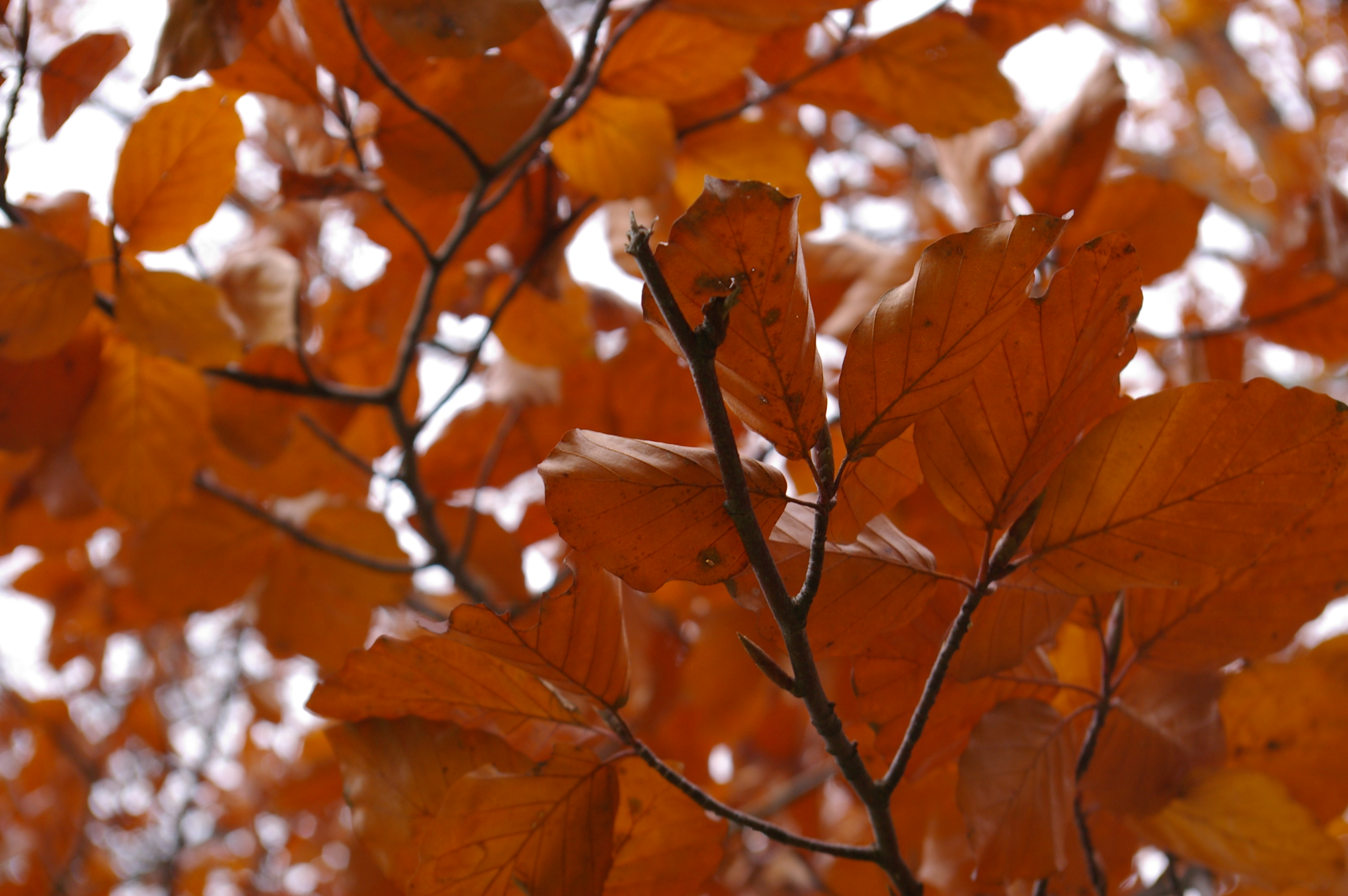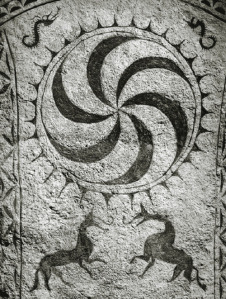Equinox – Of Sunna’s Fiery Kiss Goodbye and the Defenders of Day
by Catherine Heath
It’s that time of year again.
You know, that time of year when the temperatures may only be a little cooler, but there’s that smell in the air. It’s a delicious smell, one that reminds me of gathering close with friends around a fire with a warm mug of something in hand, and telling stories as the darkness encroaches.
Then there’s the way the light looks. No longer bright in that harsh way we see during those punishing dog days of summer – those final weeks of heat and humidity when you are just. so. over. It. (Or at least I am.) During these days, these first days of cooler air and softer light that herald the arrival of fall, the harsh brightness of Sunna gradually becomes as gentle as a lover’s kiss upon the skin.
 Soon the leaves will change, and the trees become bejeweled with their autumnal colors. Our world becomes a riot of countless shades of yellow, orange, red, and brown. It’s a blazing swan song for yet another dying year.
Soon the leaves will change, and the trees become bejeweled with their autumnal colors. Our world becomes a riot of countless shades of yellow, orange, red, and brown. It’s a blazing swan song for yet another dying year.
Eventually the light will fade, and Sunna’s kisses will lose their gentle warmth as autumn sets in and the earth prepares for the long sleep of winter under a blanket of white. We are entering a time of change and ebb; of darkening and drawing in. Many people seem to struggle with how to celebrate the Fall Equinox, but for a sun worshipper like myself, there is much inspiration to be had at this pivotal time.
A Cyclical Drama
For me, the story – because this way of looking at it only really works within the  context of a wider story reenacted over the course of a year – begins at the Spring Equinox. Called ‘Ostara’ in the Norse hearth culture, this high day is named for a goddess whose name is thought to derive from the PIE *haéusōs-, or ‘dawn’ and is cognate to the names of other dawn goddesses (Mallory and Adams Pp. 148-149). The dawn is that which precedes the light, the divine breaker of that tension between night and day. For me though, she is not only that divine breaker of tension between night and day, but also between the dark and light halves of the year. She is the goddess who precedes the rise of Sunna whose height is celebrated at Litha, and though we entice her with prayers and offerings, we also ask her not to tarry: for day cannot come if dawn will not move on, and night cannot be banished without her arrival.
context of a wider story reenacted over the course of a year – begins at the Spring Equinox. Called ‘Ostara’ in the Norse hearth culture, this high day is named for a goddess whose name is thought to derive from the PIE *haéusōs-, or ‘dawn’ and is cognate to the names of other dawn goddesses (Mallory and Adams Pp. 148-149). The dawn is that which precedes the light, the divine breaker of that tension between night and day. For me though, she is not only that divine breaker of tension between night and day, but also between the dark and light halves of the year. She is the goddess who precedes the rise of Sunna whose height is celebrated at Litha, and though we entice her with prayers and offerings, we also ask her not to tarry: for day cannot come if dawn will not move on, and night cannot be banished without her arrival.
If Ostara is the dawning of the light half of the year, then for me, the Fall Equinox is the twilight. It is when Sunna begins her descent into the Underworld of the dead half of the year. Of course, we know she doesn’t really die, or indeed go anywhere – for us, it’s all part of the sacred drama. But if there is one thing that legends such as that of the sun being pursued by Fenris teach us, it’s that the fear of losing the sun was a very real one in the past.
Of Twin Gods and Horses
This is where the Divine Twins come in. Known by many names, in many Indo-European cultures, the Divine Twins are two of the most neglected gods by modern Neopagans. For the Greeks and Romans, they were known as the Dioskouroi and Castor and Pollux respectively. In the Vedic sources they are the Ásvins, the Pagan Lithuanians knew them as the Ašvieniai, and among the Latvians, they were the Dieva dēli. In Sicily, they were the Palici, and among the Germanic tribes, they were the Alcis.
Sometimes they also appear as the divine(?) founders of a civilization, such as Romulus and Remus of Roman tradition, and the Anglo-Saxon Horsa and Hengest (Mallory and Adams Pp. 161 -165)
Regardless of where they are found though, the Divine Twins are connected with (and often depicted as) horses, boat journeys over water, and were prayed to as rescuers and healers. The worship of the Divine Twins is ancient, and their echoes may be found in almost every Indo-European descendant culture. One of those echoes, that is yet preserved in Latvian, Vedic, and Greek myth, is that of the Divine Twins as rescuers of the sun goddess/the sun’s daughter/or even the dawn goddess (Puhvel 228, Mallory and Adams Pp. 161-165)). It is in this aspect that I worship the Divine Twins at the Fall Equinox.
In Latvian myth (the best preserved iteration of this mytheme), it is from certain death by water that the Dieva dēli saved this sun-related figure. I find it significant that this solar figure was threatened by water, which was widely considered to be a medium through which one may enter the Underworld of the dead (Heide 2011), and which we also relate to the Underworld of the Mighty Dead in ADF.
 Moving further back in time, but with less certainty, we find twin figures painted on Scandinavian rocks. Created in the Bronze age, these pictographs often depict two twin weapon-carrying figures on a boat with a solar symbol also upon it.
Moving further back in time, but with less certainty, we find twin figures painted on Scandinavian rocks. Created in the Bronze age, these pictographs often depict two twin weapon-carrying figures on a boat with a solar symbol also upon it.
 Going further forward in time again, we find depictions that reinforce this idea that the Divine Twins were connected with the sun, such as on this picture stone from Gotland.
Going further forward in time again, we find depictions that reinforce this idea that the Divine Twins were connected with the sun, such as on this picture stone from Gotland.
Approaching the Gates
In the Classical world, the Divine Twins were also symbolized by the dokana – a structure comprised of two upright supports connected by two cross beams (Silver 99-100), a structure that is curiously not so different from the portals that have been found built in front of burial mounds (Hem-Eriksen 2013).
Hopefully you can see where I’m going with this with regards to the Autumn Equinox.
As I emphasized at the beginning of this piece with all my verbiage and prose, the Equinoxes are transitional; they might even be thought of as gateway times between the light half of life and growth, and the dark half of death and wane. Our ancestors were people who feared the loss of the sun, and though we no longer share their fears, there is still something deep, meaningful, and primal in enacting rituals that reflected those old fears (while also honoring the deities they turned to to try and ward off those catastrophes). It is the art of sacred drama and remembrance that works well here.
Leaving the Harvest Behind
For those who do not find the Fall Equinox particularly inspiring as a harvest festival, consideration of the equinox within the context of the solar year can provide a different (and hopefully more meaningful) direction to go in. Groups can construct dokanas to be included in solar rites. These can be created with the understanding that the dokana not only symbolizes the point of the year, but also that point of tension between light and dark/life and death. A good way to include the dokana in a rite would be to ritualistically decorate its pillars in harvest foliage. Prayers and offerings can then be made at its posts for the safe passage of the sun through the dark underworld of the approaching winter.
Within ADF, we have the tradition of calling upon gatekeeper deities and spirits. Normally this is thought of as being a borrowing from Afro-Caribbean religions, but regardless of its origins, it is a part of what we do now. As is the Fall Equinox celebration itself. However,I think the liminality of this time lends itself well to being a time to honor those gatekeepers – even outside of the context of a solar cult. This article was an exploration of one of the ways that one set of gatekeeper deities can be honored at this time, there is plenty of scope for creation here.
We just need to look beyond the harvest.
Sources
Mallory, J. P., and Douglas Adams Q. Encyclopedia of Indo-European Culture. London: Fitzroy Dearborn, 1997. Print.
Puhvel, Jaan. Comparative Mythology. Baltimore: Johns Hopkins UP, 1987. Print.
Heide, Eldar. “Holy Islands and the Otherworld: Places Beyond Water.”Isolated Islands in Medieval Nature, Culture and Mind. By Torstein Jørgensen and Gerhard Jaritz. Budapest: Central European UP, 2011. 57-80. Print.
Silver, Morris. “Agents in Myth II: Twins.” Taking Ancient Mythology Economically. Leiden: Brill, 1992. 99-100. Print.
Hem Eriksen, Marianne. “Doors to the Dead. The Power of Doorways and Thresholds in Viking Age Scandinavia.” Academia.edu. N.p., n.d. Web. 10 Sept. 2016.





